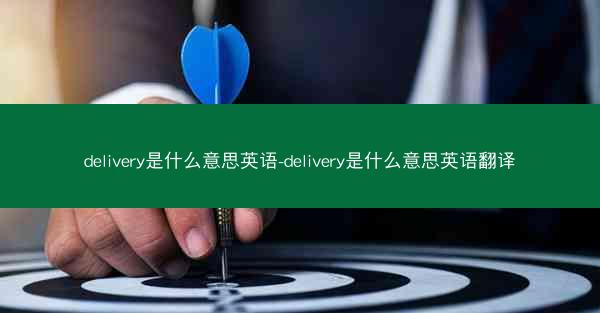delivery是什么意思英语-delivery是什么意思英语翻译
 telegram中文版
telegram中文版
硬件:Windows系统 版本:11.1.1.22 大小:9.75MB 语言:简体中文 评分: 发布:2020-02-05 更新:2024-11-08 厂商:telegram中文版
 telegram安卓版
telegram安卓版
硬件:安卓系统 版本:122.0.3.464 大小:187.94MB 厂商:telegram 发布:2022-03-29 更新:2024-10-30
 telegram ios苹果版
telegram ios苹果版
硬件:苹果系统 版本:130.0.6723.37 大小:207.1 MB 厂商:Google LLC 发布:2020-04-03 更新:2024-06-12
跳转至官网

Introduction to the Concept of Delivery
Delivery, in its most basic form, refers to the act of transporting goods or services from one place to another. It is a fundamental aspect of logistics and supply chain management, ensuring that products reach the intended recipients in a timely and efficient manner. The term delivery can be applied to various contexts, including shipping, transportation, and even the delivery of services.
Types of Delivery Methods
1. Standard Delivery: This is the most common type of delivery, where goods are transported using standard shipping methods. It typically involves the use of trucks, trains, or ships, depending on the distance and nature of the goods.
2. Express Delivery: Express delivery services offer faster transportation options, ensuring that goods are delivered within a shorter timeframe. This method is often used for urgent or time-sensitive deliveries.
3. Same-Day Delivery: As the name suggests, same-day delivery involves delivering goods on the same day they are ordered. This is a premium service that requires efficient logistics and transportation systems.
4. Door-to-Door Delivery: This method involves delivering goods directly to the recipient's doorstep. It is a convenient option for customers who prefer not to visit a warehouse or distribution center to pick up their orders.
5. Pick-Up Delivery: In this method, the recipient is responsible for picking up the goods from a designated location, such as a warehouse or distribution center.
The Importance of Delivery in Business
1. Customer Satisfaction: Efficient delivery ensures that customers receive their orders on time, leading to higher satisfaction levels. This can help businesses build a loyal customer base and improve their reputation.
2. Competitive Advantage: Offering reliable and timely delivery can give a business a competitive edge over its competitors. Customers are more likely to choose a business that can deliver their products quickly and efficiently.
3. Cost Management: Effective delivery management can help businesses reduce transportation and logistics costs. This can be achieved through optimized routes, efficient packaging, and the use of technology to track shipments.
4. Inventory Management: Delivery plays a crucial role in inventory management. By ensuring that goods are delivered on time, businesses can maintain optimal inventory levels and avoid stockouts or overstock situations.
The Role of Technology in Delivery
1. Tracking Systems: Advanced tracking systems allow businesses to monitor the progress of their deliveries in real-time. This helps in providing accurate delivery updates to customers and ensures that goods are delivered safely and on time.
2. Automation: Automation tools, such as delivery drones and autonomous vehicles, are increasingly being used to improve the efficiency of delivery processes. These technologies can help reduce costs and increase delivery speed.
3. Customer Communication: Technology enables businesses to communicate effectively with customers regarding their deliveries. This includes sending delivery notifications, providing estimated delivery times, and allowing customers to track their shipments online.
The Challenges of Delivery
1. Traffic and Infrastructure: Traffic congestion and inadequate infrastructure can significantly impact delivery times and efficiency. Businesses need to plan their delivery routes carefully to avoid delays.
2. Weather Conditions: Adverse weather conditions, such as heavy rain, snow, or storms, can disrupt delivery schedules and cause delays. Businesses must be prepared to handle such situations and have contingency plans in place.
3. Security and Safety: Ensuring the security and safety of goods during transportation is a critical concern. Businesses must implement robust security measures to protect their products from theft, damage, or loss.
The Future of Delivery
1. Sustainability: As environmental concerns continue to grow, businesses are increasingly focusing on sustainable delivery methods. This includes using eco-friendly vehicles, optimizing delivery routes to reduce carbon emissions, and promoting recycling and waste reduction.
2. Personalization: The future of delivery may involve personalized services, where customers have more control over their delivery preferences. This could include choosing delivery times, selecting preferred delivery methods, and even customizing packaging.
3. Integration with E-commerce: The integration of delivery services with e-commerce platforms will become more seamless, providing customers with a hassle-free shopping experience. This will involve real-time tracking, easy returns, and efficient customer support.
In conclusion, delivery is a critical aspect of logistics and supply chain management, ensuring that goods and services reach their intended recipients in a timely and efficient manner. As technology continues to evolve, the delivery industry will witness significant changes, offering businesses and customers more options and benefits.












